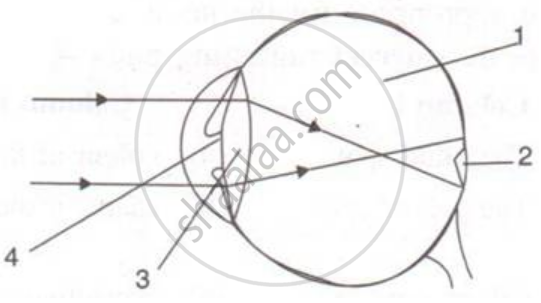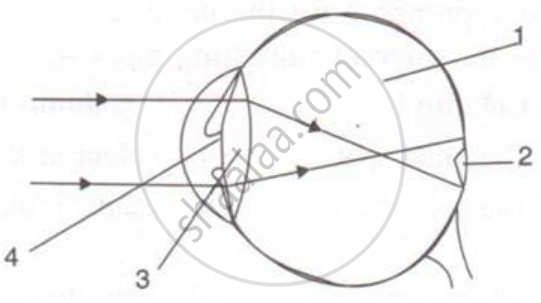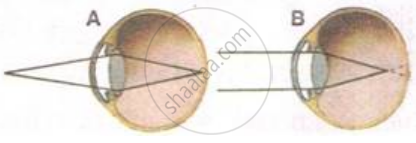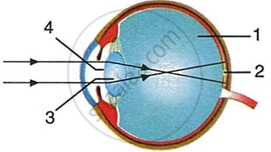Advertisements
Advertisements
प्रश्न
Explain two possible reasons of myopia. How can it be corrected? Explain with a suitable diagram.
उत्तर
Possible reasons of myopia:-
(i) Ciliary muscles do not relax sufficiently. Therefore, the converging power of the eye lens becomes high.
(ii) The distance between the eye lens and the retina increases (relative to the normal eye) as the eyeball is lengthened (elongated) or the eye lens is curved.
Correcting myopia:-
(i) Myopia is corrected using a suitable concave lens. Light rays are diverged by the concave lens before they strike the eye lens.
(ii) A concave lens of appropriate power is chosen to produce the required divergence. Hence, after the converging action of the eye lens, the image is formed on the retina.

APPEARS IN
संबंधित प्रश्न
What is the far point and near point of the human eye with normal vision?
Name the defect of vision in a person:
whose far point is less than infinity
Which defect of vision can be rectified:
by using a concave lens?
Where is the near point of a person suffering from hypermetropia (or long-sightedness)?
Your friend can read a book perfectly well but cannot read the writing on blackboard unless she sits on the front row in class.
What type of lenses-converging or diverging-would an optician prescribe for her?
A student sitting in the last row of the class-room is not able to read clearly the writing on the blackboard.
Name the type of defect he is suffering from.
What are the two most common defects of vision (or defects of eye)? How are they corrected?
Differentiate between myopia and hypermetropia. What type of spectacles should be worn by a person having the defects of myopia as well as hypermetropia? How does it help?
Explain with the help of labelled ray-diagram, the defect of vision called hypermetropia, and hot it is corrected by a lens.
A person suffering from the eye-defect myopia (short-sightedness) can see clearly only up to a distance of 2 metres. What is the nature and power of lens required to rectify this defect?
The near-point of a person suffering from hypermetropia is at 50 cm from his eye. What is the nature and power of the lens needed to correct this defect? (Assume that the near-point of the normal eye is 25 cm).
What is short-sightedness? State the two causes of short-sightedness (or myopia). With the help of ray diagrams, show:
(i) the eye-defect short-sightedness.
(ii) correction of short-sightedness by using a lens.
The defect of vision which cannot be corrected by using spectacles is:
(a) myopia
(b) presbyopia
(c) cataract
(d) hypermetropia
A person can read a book clearly only if he holds it at an arm's length from him. Name the defect of vision:
if the person is a young man
Differentiate between members of the following pair with reference to what is asked in the bracket.
Rods and cones (sensitivity).
A person cannot read newspaper placed nearer than 50 cm from his eyes. Name the defect of vision he is suffering from. Draw a ray diagram to illustrate this defect. List its two possible causes. Draw a ray diagram to show how this defect may be corrected using a lens of appropriate focal length.
An old man cannot see objects closer than 1 m from the eye clearly. Name the defect of vision he is suffering from. How can it be corrected? Draw ray diagram for the (i) defect of vision and also (ii) for its correction.
Write whether the following is true or false:
A convex lens is used for correcting myopia.
Given below is a diagram depicting a defect of the human eye? Study the same and answer the question that follow:

Give two possible reasons for this defect of the eye in human beings.
Given below is a diagram depicting a defect of the human eye? Study the same and answer the question that follow :

Name the type of lens used to correct this eye defect.
Given below is a diagram depicting a defect of the human eye? Study the same and answer the question that follow:

Draw a labeled diagram to show how the above mentioned defect is rectified using the lens named above.
Have a look at the posture of this woman who is reading a book and answer the questions which follow:

What are the two conditions shown in sections A and B of the eye as applicable to her?
Anuja cannot see the blackboard writing but she can see nearby things.
(a) What is the eye defect she is suffering from?
(b) State the possible reason for her defect.
(c) How is it corrected
The near point of the eye of a person is 50 cm. Find the nature and power of the corrective lens required by the person to enable him to see clearly the objects placed at 25 cm from the eye?
A person is unable to see objects distinctly placed within 50 cm from his eyes.
(a) Name the defect of vision the person is suffering from and list its two possible causes.
(b) Draw a ray diagram to show the defect in the above case.
(c) Mention the type of lens used by him for the correction of the defect and calculate its power. Assume that the near point for the normal eye is 25 cm.
(d) Draw a labeled diagram for the correction of the defect in the above case.
The diagram given below represents the cross-section of the human eye:

(i) Name the parts labeled 1—12.
(ii) What is the function of the part marked ‘10’?
(iii) What would happen if part ‘5’ is damaged or cut?
Choose the Odd One Out:
Due to elongation of _______ and increase in curvature of the eye lens, a person cannot see distant objects clearly.
Write scientific reason.
Nearsightedness, this defect can be corrected by using spectacles with concave lens.
A person cannot see distinctly objects kept beyond 2 m. This defect can be corrected by using a lens of power:
Assertion: Myopia is the defect of vision in which a person cannot see distant objects clearly.
Reason: This due to eye-ball being too short.
Which of the following statement is correct?
Which of the following statement is correct?
A person is unable to see clearly a poster fixed on a distant wall. He however sees it clearly when standing at a distance of about 2 m from the wall.
- Draw ray diagram to show the formation of image by his eye lens when he is far away from the wall.
- List two possible reasons of this defect of vision.
- Draw ray diagram to show the correction of this defect using appropriate lens.
Complete the following table by observing the given figures:
| Figure → |  |
 |
| Points ↓ | ||
| (a) Name of the defect | ______ | ______ |
| (b) Position of the image | ______ | ______ |
| (c) Lens used to correct the defect | ______ | ______ |
Given alongside is a diagram depicting a defect of the human eye. Study the same and answer the questions that follow:
 |
- Name the defect shown in the diagram.
- Give two possible reasons for this defect.
- Name the parts labelled 1 to 4.
- Name the type of lens used to correct this eye defect.
- Draw a labelled diagram to show how the above mentioned defect is rectified using the lens named above.
